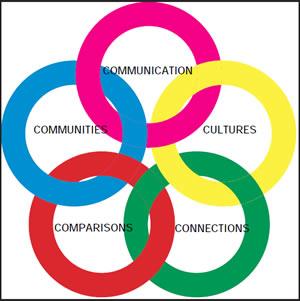Foreign Language
-
Language and communication are at the heart of the human experience. The United States must educate students who are linguistically and culturally equipped to communicate successfully in a pluralistic American society and abroad. This imperative envisions a future in which ALL students will develop and maintain proficiency in English and at least one other language, modern or classical. Children who come to school from non-English backgrounds should also have opportunities to develop further proficiencies in their first language.
STANDARDS FOR FOREIGN LANGUAGE LEARNING
COMMUNICATION:Communication is at the heart of second language study, whether the communication takes place face-to-face, in writing, or across centuries through reading of literature.
COMMUNICATE IN LANGUAGES OTHER THAN ENGLISH
- Standard 1.1: Students engage in conversations, provide and obtain information, express feelings and emotions, and exchange opinions
- Standard 1.2: Students understand and interpret written and spoken language on a variety of topics
- Standard 1.3: Students present information, concepts, and ideas to an audience of listeners or readers on a variety of topics.
CULTURES:Through the study of other languages, students gain a knowledge and understanding of the cultures that use that language and, in fact, cannot truly master the language until they have also mastered the cultural contexts in which the language occurs.
GAIN KNOWLEDGE AND UNDERSTANDING OF OTHER CULTURES
- Standard 2.1: Students demonstrate an understanding of the relationship between the practices and perspectives of the culture studied
- Standard 2.2: Students demonstrate an understanding of the relationship between the products and perspectives of the culture studied
CONNECTIONS:Learning languages provides connections to additional bodies of knowledge that may be available to the monolingual English speaker.
CONNECT WITH OTHER DISCIPLINES AND ACQUIRE INFORMATION
- Standard 3.1: Students reinforce and further their knowledge of other disciplines through the foreign language
- Standard 3.2: Students acquire information and recognize the distinctive viewpoints that are only available through the foreign language and its cultures
COMPARISONS:Through comparisons and contrasts with the language being studies, students develop insight into the nature of language and the concept of culture and realize that there are multiple ways of viewing the world.
DEVELOP INSIGHT INTO THE NATURE OF LANGUAGE AND CULTURE
- Standard 4.1: Students demonstrate understanding of the nature of language through comparisons of the language studied and their own
- Standard 4.2: Students demonstrate understanding of the concept of culture through comparisons of the cultures studied and their own.
COMMUNITIES:Together, these elements enable the student of languages to participate in multilingual communities at home and around the world in a variety of contexts and in culturally appropriate ways.
PARTICIPATE IN MULTILINGUAL COMMUNITIES AT HOME & AROUND THE WORLD
- Standard 5.1: Students use the language both within and beyond the school setting
- Standard 5.2: Students show evidence of becoming life-long learners by using the language for personal enjoyment and enrichment.


